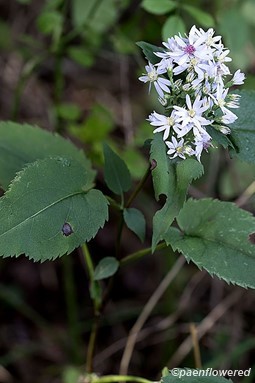Symphyotrichum cordifolium
Blue-flowered aster with heart-shaped leaves
Symphyotrichum cordifolium blue wood aster
This native perennial aster is fairly easy to identify because of its sharp-toothed broad, heart-shaped leaves, often deeply notched at their base. Because it is a variable species, it can be mistaken for the large-leaved aster that has much bigger leaves and for Schreber’s aster which has white flowers and a more blunt indentation at the petiole. The heartleaf aster has composite flowers ½ to 5/8 inch in diameter, formed in dense dome-shaped clusters. The 14-20 central disc flowers turn red early while the 8-15 ray flowers are pale blue-violet. The floral bracts are smooth, narrow, and blunt. The upper leaves may lack the deep notch of the lower leaves and may be more oval in shape.
The heartleaf aster grows one to four feet tall and blooms between August and October. It is found in rich moist soil of open woods and clearings in sun or shade. It grows in southern Canada and the northeastern United States but can be found further south in the mountains. It can be found growing in most counties of Western Pennsylvania. A variety of insects, including bumblebees, visit the flowers for nectar. It is also called the blue wood aster.
Habitat & Range
Common in woods, meadows, and roadsides.
Present throughout the state.
Wetland code: Not classified
Phenology
Flowers late August through early October.
Characteristics
Flowers branching cluster of daisy-like, stalked flowers at the top of plant and arising from upper leaf axils. Flowers have 8 to 15 rays surrounding a creamy yellow center disk that turns reddish with age. Ray color varies from almost white to lavender to gentle blue.
Leaves thin, coarsely toothed, mostly cordate with winged petioles. The upper and lower surfaces of the leaves are generally hairless but can have some hair, especially on the veins. Basal and lower stem leaves usually wither away by flowering time, and have longer stalks with narrow wings. Farther up the stem, stalks become shorter and wings become broader, blades less cordate.
Fruit flower heads turn into seed heads with tufts of light brown hair that get carried off by the wind. Seed is light brown, angled with 4 to 5 veins.
Identification Tips
Heart-shaped, coarsely-toothed leaves, often with winged stalks.
Stem usually hairless below the flower cluster.
Plant Codes
S-rank: No rank
G-rank: G5 (Secure)
Symphyotrichum cordifolium blue wood aster
Add to MyPlants View LocationsPlant Summary
Common Names
Symphyotrichum



























Comments
Have you spotted this plant in your area? We'd love to hear about your experience! Share your comments or questions about the plant below. Comments are moderated before posting.